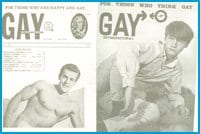Last month three OPP officers led by Det Insp Phil George strode into a packed room at the 519 Community Centre on a mission.
They were there to ask 70 or so members of the Prime Timers gay seniors group for help determining the identities of two young men whose skeletal remains had been discovered in 1967 and 1968 in rural locations north of Toronto. Last month the OPP reactivated the cases, suggesting that the two victims met their killer in Toronto’s gay community the summer of 1967.
The OPP asked the seniors to take a look at the two facial reconstructions, one of a young man believed to be between 15 and 18, the other between 18 and 25, hoping the seniors of today might have clues about what went on 1967.
“I know a lot of you around the room have the same memories of 1967 that I did,” George, who is 54, told the seniors. “We know that there was a sexual predator working the Toronto area and he has been convicted of attacks on a male and a female.”
All of which raises the question of what the police did back then — before Stonewall or Canada’s We Demand statement of 1971, demanding fair treatment for homosexuals. Would the police have even cared about a killer targeting gay men? Would gay men have trusted the police enough to come forward?
As skeptical Prime Timers asked why police had waited 40 years to pursue the case, George seemed clueless about the level of fear of the police among gay men in the 1960s.
“Gay people didn’t have a lot of trust in them then,” says Bob Tivey. “Many had experienced terror and fear and harassment at the hands of the cops. They used to stop us for no reason at random, just for coming out of gay bars at night or being on the street at night. We feared the police and they treated us like dirt.”
This was the same year the late activist George Hislop asked the police chief of the day if he would consider an informal liaison with the gay community.
“But homosexuals are incipient criminals. Why would I want to meet with criminals?” the chief told Hislop.
As gay oral historian John Grube concluded after interviews pre-Stonewall gay men for an ’80s research project: “All gay men have a police story, just like every gay man has a coming out story.”
This is certainly true of the Prime Timers president, Gus Kieley. In the ’60s he was arrested for a misdemeanor and was pressured by the police to admit that he was homosexual, a crime at the time and information that would be passed on to the RCMP.
“It would have cost $2,000 minimum to fight the charges and I did not have the money,” says Kieley, who plead guilty, paid a fine and spent one night in jail. “And there was no support from the community.”
Which isn’t to say there wasn’t an active gay life in Toronto at that time, centred on Yonge St between College and Wellesley where bars like the St Charles and the Parkside were located, and near Bay and College where the hustlers hung out.
Don McLeod, in A Brief History Of Gay, a magazine from that era, quotes the poet Edward Lacey about the wildness of gay life in Toronto back then.
“There are now three or more dance clubs open to three or four in the morning and since they are theoretically private, anything goes in them,” wrote Lacey. “The homosexual population of the city seems, to me, to have quadrupled, so it’s hard to get a good-looking hustler to oneself anymore — no sooner does he walk into a bar than he is surrounded.”
While it flourished, gay life was still outside the law. Police used to entrap gay men for sexual offences in the Parkside washroom — with the complicity of management. In 1972 Hislop organized a protest, management capitulated and the police retreated.
Graphic designer Jon Lidolt says that, out of sight of the police and government control, it wasn’t a bad time: “It was an underground fairyland.”

 Why you can trust Xtra
Why you can trust Xtra


